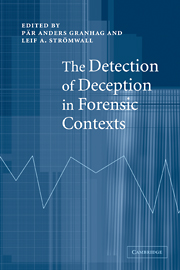Book contents
- Frontmatter
- Contents
- List of figures
- List of tables
- List of contributors
- Part 1 Introduction
- Part 2 Lie-detection techniques
- Part 3 Special issues facing a lie-catcher
- Part 4 Enhancing lie-detection accuracy
- Part 5 Conclusions
- 14 Research on deception detection: intersections and future challenges
- Index
- References
14 - Research on deception detection: intersections and future challenges
Published online by Cambridge University Press: 22 September 2009
- Frontmatter
- Contents
- List of figures
- List of tables
- List of contributors
- Part 1 Introduction
- Part 2 Lie-detection techniques
- Part 3 Special issues facing a lie-catcher
- Part 4 Enhancing lie-detection accuracy
- Part 5 Conclusions
- 14 Research on deception detection: intersections and future challenges
- Index
- References
Summary
This volume has offered a collection of state-of-the-art chapters on deception detection. The focus has been set on the different types of deception taking place in forensic contexts, and the different methods proposed in order to detect these attempts. In this closing chapter we will highlight a few, as we believe, important intersections and we will offer hints about some future challenges. We will end by a brief note on how to view and use the knowledge presented in the volume.
Intersections
When juxtaposing the chapters in this volume, several common themes can be noted, and below we will highlight three such intersections. All three mirror the recent shift in research focus: from studies examining people's ability to detect deception, to studies on how people's deception detection performance can be enhanced (Granhag and Vrij, in press). We consider these intersections to have immediate practical implications, as well as laying common ground for future research.
Combining different methods
In his preface to the Maratea volume, Yuille (1989) noted that each of the three traditional approaches to deception detection (psychophysiological, non-verbal, and verbal content) ‘has developed and remained independent of the others’ (p. viii). One of the Maratea conference's goals was to examine possible and potential relationships between the different approaches. Judging from its proceeding volume, the meeting did not result in any integrated method for detecting deception.
- Type
- Chapter
- Information
- The Detection of Deception in Forensic Contexts , pp. 317 - 330Publisher: Cambridge University PressPrint publication year: 2004
References
- 5
- Cited by



